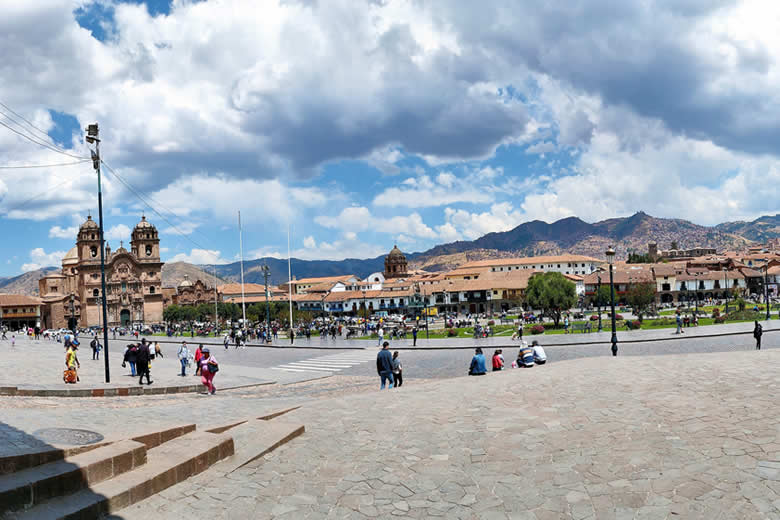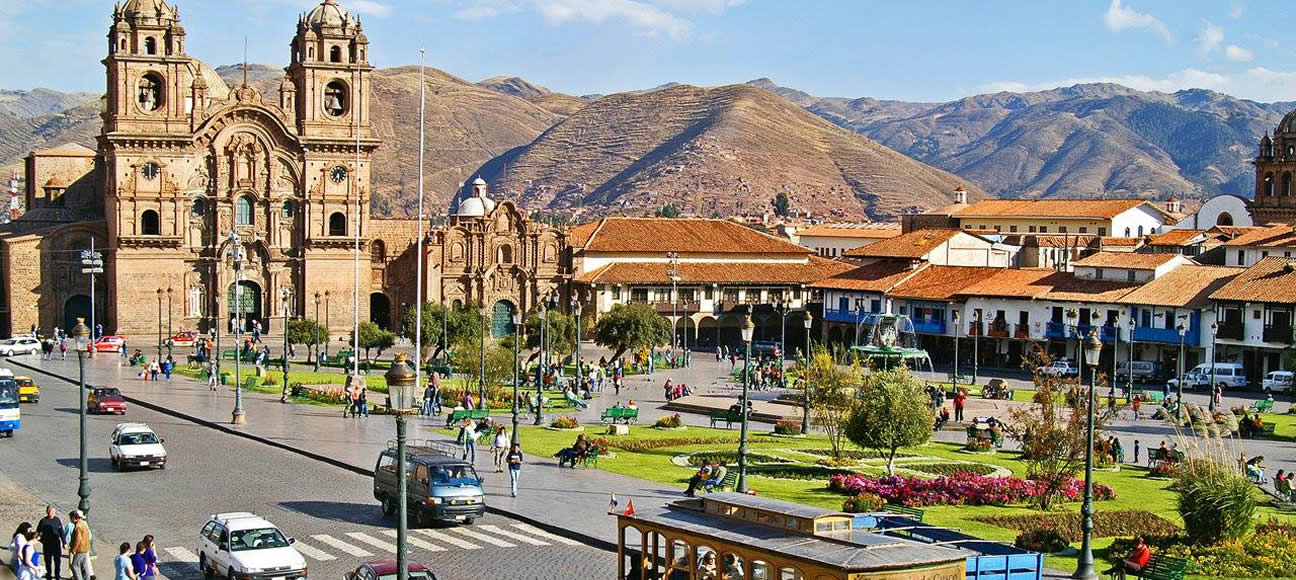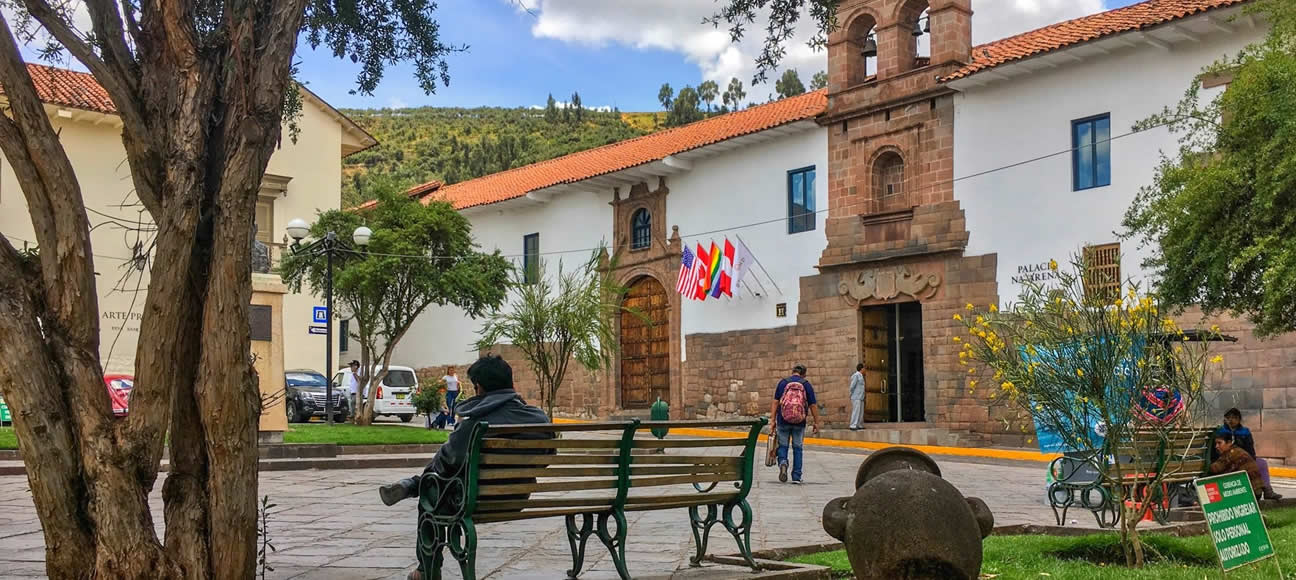The historical center of Cusco is recognized as a UNESCO World Heritage Site. It is considered a masterpiece of the Inca architecture and a testimony to the Andean cultural tradition. The city of Cusco was the capital of the Inca Empire and the site includes numerous monuments and buildings that reflect the cultural and architectural fusion between the Inca and Spanish colonial styles. The historic center of Cusco attracts millions of visitors per year.
Streets of Cusco

Plaza de Armas
This historic square is the heart of the city. Here you can see the Cathedral of Cusco and the Church of the Company. It's a popular spot for locals and tourists, and many colonial-style buildings surround it.

Calle Hatun Rumiyoc
This street goes up to the San Blas neighborhood. It is famous for its stunning Inca stonework, including the "Twelve-Angled Stone," a unique architectural feature showcasing the Inca's engineering skills.

Cuesta San Blas
This narrow street is the continuation of Calle Hatun Rumiyoc, known for its picturesque traditional Andean houses, and it's a great place to explore the local art scene.
Calle del Medio
This street runs parallel to the Plaza de Armas and is known for its traditional colonial-style architecture. You can in a few shops and restaurants.
Calle Plateros:
This street is home to many of Cusco's famous jewelry shops, and it's a great place to purchase traditional Andean silverwork. It ends on the Plaza de Armas.
Calle Triunfo:
This central street is known for its many bars, restaurants, and souvenir shops.
Calle Procuradores:
Also Calle Procuradores is a located in the monumental zone of the city of Cusco.Currently, the narrow street houses several lodging establishments, restaurants, and travel agencies. It is also the central point of the informal supply of these services and the sale of drugs.
Calle Loreto:
Calle Loreto is great for people interested in beautiful Inca stonework and exploring Cusco's local culture and history. The street is easily accessible from the Plaza de Armas. One of the most important places to visit on Calle Loreto is the Church of Loreto; it's a beautiful colonial-style church that dates back to the 16th century; it's known for its intricate carvings and frescoes. The church is home to many important religious artifacts and is an important sacred site for the local community.
Calle Siete Borreguitos
Calle Siete Borreguitos is a street located in the historic center of Cusco, in San Blas. It used to be a small, relatively unknown street among tourists, but it has now become famous as one of the most 'instagrammable' streets of Cusco! You'll see some colonial-style architecture; it is a peaceful and quiet place.
Avenida del Sol
The Avenida del Sol is a major avenue in the city of Cusco lined with shops, restaurants, hotels, and other tourist-oriented businesses. The avenue is located near many of the city's most popular tourist attractions, including the Plaza de Armas, the Cathedral of Cusco, and the Temple of the Sun, among others.
The Av. del Sol is a busy street that is frequently congested with traffic, especially during peak tourist season. It is also a hub of local life in Cusco, close to many of the city's public transportation options, including bus and taxi services.
Plazas of Cusco
Plaza de Armas
Cusco, the ancient capital of the Inca Empire, is home to several important plazas and squares that are steeped in history and cultural significance. The central Plaza, known as the Plaza de Armas, is the central hub of the city and is surrounded by many of the city's most important buildings, including the Church of La Compañía and Cusco Cathedral, one of the most emblematic buildings of the ancient capital of the Inca Empire. The Plaza de Armas also serves as a popular gathering spot for locals and tourists and is the site of many festivals and events throughout the year. The Plaza de Armas is also home to the Palace of the Inca, the former residence of the Inca emperor. It's the place of many festivals, parades, and events, such as Inti Raymi, the Inca festival of the Sun, which is celebrated every June.
The Plaza de Armas is also the ideal place to start a tour of Cusco, as many of the city's most important landmarks are within walking distance. Overall, the Plaza de Armas is a must-see destination for anyone visiting Cusco, as it offers a glimpse into the city's rich history and culture.

Plaza de Armas
Plaza San Francisco
The Plaza de San Francisco is also worth visiting, home to the church of San Francisco and its beautiful colonial architecture. It's located a few minutes' walk from the Plaza de Armas in downtown Cusco. The Plaza San Francisco is considered to be one of the main plazas in the city and is known for its colonial-era architecture and its historical significance. The square is surrounded by several important buildings, including the Church of San Francisco, considered one of the essential colonial-era churches in Cusco.

Plaza San Francisco
Plaza de Regocijo
The Plaza del Regocijo was separated from the Plaza de Armas of Cusco when the city was laid out in colonial times. That's why you can still see important city buildings; one of them is the Municipal building. The name (regocijo) comes from the Quechua tradition that called it Cusipata or "patio de alegría". In ancient times, public festivities such as bullfights or games of reeds were held here, in addition to the market. On this Plaza, you can see the Cabildo, a beautiful two-story building, and the Museum of Contemporary Art of Cusco. In the portals, there are a large number of shops selling handicrafts, cafes, and tourist restaurants.
The Plaza de Regocijo is also a popular spot for tourists visiting the city, as it offers a glimpse into the rich cultural heritage of Cusco. In addition, Plaza Regocijo has some beautiful trees and a fountain in the middle. You find that Plaza right between the Plaza de Armas and the Plaza San Francisco.
The Plaza Nazarenas
The Plaza Nazarenas in Cusco is a beautiful square in the city's heart. The square is surrounded by several colonial-era buildings, including the Church and Convent of Santa Catalina. This striking and ornate building is considered one of Cusco's most important examples of colonial-era architecture. The church is adorned with intricate carvings, frescoes, and sculptures and is a popular spot for tourists visiting the city.
The Plaza is also surrounded by several other colonial-era buildings, such as beautiful houses and hotels that have been converted from colonial mansions, many of which have been preserved in their original state and are open to the public. The square is a popular spot for locals and tourists alike and is a great place to relax and soak up the atmosphere of Cusco. The Plaza Nazarenas is beautiful and peaceful, surrounded by lush green gardens and large old trees. It's a perfect place to rest and enjoy the beauty of Cusco.
From the middle of the 16th century until 1629, the square was called "Plazuela del Convento de Santa Clara." It was later renamed "Plazuela de Santa Clara la Vieja" and then again "Plazuela del Colegio y Seminario de San Antonio Abad." Finally, in the 19th century, after the installation of the Beguinage de las Nazarenas in the neighboring Casa de las Sierpes, it received its final name, Nazarenas Square or Plaza Nazarenas.

The Plaza Nazarenas Cusco
Plaza San Blas
The Spanish divided the city of Cusco into eight neighborhoods, each with its own church. San Blas was where the Bishop of San Blas performed his miracles. The San Blas neighborhood (and square) is the heart of the city of Cusco. There are many restaurants and bars where you can eat, drink and enjoy great music and the company of people from all over the world. San Blas is famous for concentrating handicraft shops as well as workshops of the most famous artisans in Cusco.
San Blas is also called the 'Balcony of Cusco' because of the views if you go to the higher part. The streets are narrow and cobbled. Its colonial houses house many of the best art workshops and shops. In addition, it has typical regional and foreign food restaurants.
In the San Blas square, you'll find the San Blas Church, built in 1563 on top of an Inca temple dedicated to the god of lightning (Illapa). Inside the church, the pulpit carved in cedar attributed to the artisan Juan Tomás Tuyro Túpac stands out. You can also see beautiful pieces of art on the temple's walls. The simple abode church is small, but thanks to its exquisitely carved pulpit, it has been called the finest example of colonial wood carving in the Americas. The Plaza is excellent for relaxation, and there is a small artisan fair during the weekend.

Plaza San Blas Cusco Peru
Plaza San Christobal
Plaza San Cristobal is located in the San Cristobal neighborhood, and the name of the church on the square is called San Cristobal too. This place is one of the most traditional points of the city of Cusco and one of the many sources of inspiration as it shows a great town to those lucky enough to contemplate it from its privileged square.
The square in front of the church is wholly worked in stone, dominated by a cross made of the same material. Like many others, it is celebrated in May. The view you have of the valley of Cusco is impressive, and it is possible to see the Ausangate mountain and enjoy it both during the day and at night. The plaza San Cristobal could be considered one of the best viewpoints in the city. From the Plaza de Armas, it takes ten to fifteen minutes of walking uphill to reach this Plaza.
Plaza Tupac Amaru
The Plaza Tupac Amaru is a public square located about 20 minutes' walk from the city center and the historical part of Cusco. The square is named after Tupac Amaru, the last Inca emperor, executed by Spanish conquistadors in the 16th century.
The Plaza Tupac Amaru is a popular gathering place for locals and visitors alike and is surrounded by shops, restaurants, and other businesses. On weekends, the square is filled with vendors selling traditional Peruvian crafts and foods, and street performers entertaining the crowds. The square is also a popular spot for local festivals and events, such as concerts and cultural celebrations.